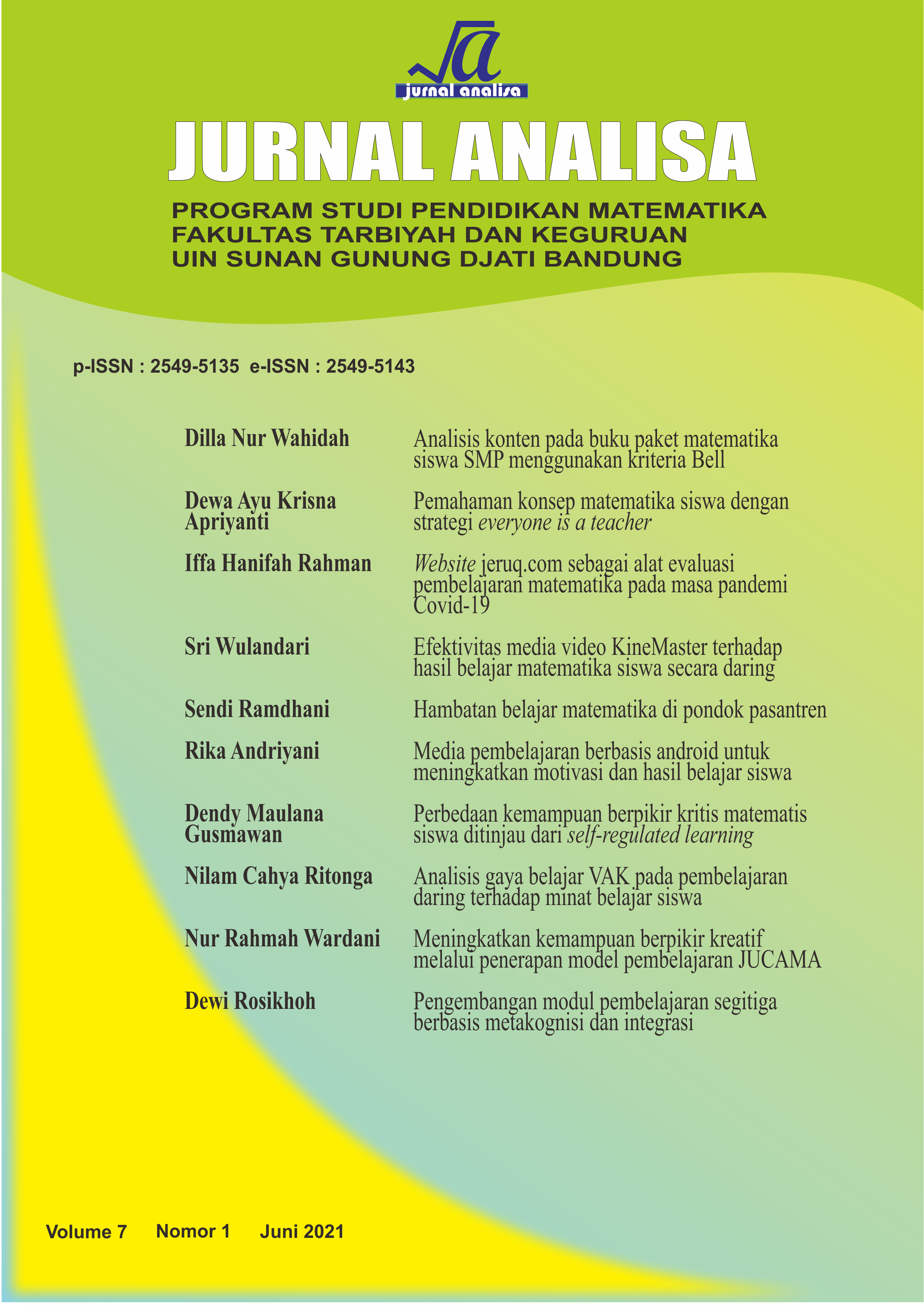Meningkatkan kemampuan berpikir kreatif melalui penerapan model pembelajaran JUCAMA
DOI:
https://doi.org/10.15575/ja.v7i1.9904Keywords:
Berpikir Kreatif, Jucama, Pemecahan Masalah, Pengajuan MasalahAbstract
Di abad ini, pendidikan menjadi lebih penting untuk memastikan siswa mendapatkan kreatifiatas maka dalam pengembangan kreatifitas secara umum maupun berpikir kreatif matematis pun menjadi penting. Namun, fakta dilapangan ditemukan kemampuan berpikir siswa masih kurang dan perlu ditingkatkan. Tujuan penelitian ini untuk mengetahui perbedaan peningkatan kemampuan berpikir kreatif matematis siswa setelah memperoleh pembelajaran JUCAMA (Pengajuan dan Pemecahan Masalah) serta perbedaan pencapaian kemampuan berpikir kreatif matematis berdasarkan kategori PAM. Metode penelitian yang digunakan adalah metode kuasi eksperimen dengan desain Non Equivalent Control Group Desain yang sampel nya diambil secara purposive sampling di salah satu sekolah Menengah Pertama di daerah Bandung. Dengan menggunakan instrumen tes PAM dan Tes Kemampuan Berpikir Kreatif ini menghasilkan beberapa temuan, yaitu: terdapat perbedaan peningkatan kemampuan berpikir kreatif matematis siswa yang menggunakan model pembelajaran JUCAMA dengan model konvensional (Pembelajaran langsung), dengan rata-rata N-Gain kelas JUCAMA 0,16 > kelas konvensional 0,10. Model pembelajaran JUCAMA ini berbasis pemecahan dan pengajuan masalah karena keduanya mendorong berkembangnya kreatifitas sehingga mampu meningkatkan kemampuan berpikir kreatif matematis. Dapat disimpulkan setelah siswa memperoleh pembelajaran dengan model pembelajaran JUCAMA lebih baik dari pembelajaran konvensional.
Kata kunci: Berpikir Kreatif, JUCAMA, Pemecahan Masalah, Pengajuan Masalah
In this century, education is becoming more important to ensure students get creativity, so in general the development of creativity and mathematical creative thinking is also important. However, the facts in the field found that students' thinking skills were still lacking and needed to be improved. The purpose of this study was to determine the differences in the improvement of students' mathematical creative thinking skills after obtaining JUCAMA (Problem Submission and Solving) learning and the differences in the achievement of mathematical creative thinking abilities based on the PAM category. The research method used is a quasi experimental method with a Non Equivalent Control Group Design whose samples were taken by purposive sampling in one of the junior high schools in the Bandung area. Using the PAM test instrument and the Creative Thinking Ability Test resulted in several findings, namely: there are differences in the improvement of students' mathematical creative thinking skills using the JUCAMA learning model with the conventional model (Direct learning), with an average JUCAMA class N-Gain 0.16 > conventional class 0.10. This JUCAMA learning model is based on problem solving and proposing because both encourage the development of creativity so as to improve mathematical creative thinking skills. It can be concluded that after students get learning with the JUCAMA learning model, it is better than conventional learning.
Keywords: Creative thinking skill, JUCAMA, Problem Based, Problem Posing
References
Agustina, W., & Noor, F. (2016). Hubungan hasil belajar dan tingkat berpikir kreatif siswa dalam pembelajaran matematika. Math Didactic: Jurnal Pendidikan Matematika, 2(3), 191–200.
Bona, M. F. (2019). Guru Sulit Ajarkan Siswa untuk Berpikir Kreatif. (https://www.google.com/amp/s/amp.beritsatu.com/nasional/550513/guru-sulit-ajarkan-siswa-untuk-berpikir-kreatif/) diakses 8 Januari 2020
Elgrably, H., & Leikin, R. (2021). Creativity as a function of problem-solving expertise: posing new problems through investigations. ZDM–Mathematics Education, 1-14
Fox, S., & Surtees, L. (2010). Mathematics across the curriculum: Problem-solving, reasoning and numeracy in primary schools. A&C Black.
Hendriana, H., & Soemarmo, U. (2017). Penilaian Pembelajaran Matematika. (N. F. Latif, Ed.). Bandung: PT Refika Aditama.
Mulyaningsih, T., & Ratu, N. (2017). Analisis Kemampuan Berpikir Kreatif Siswa SMP dalam Memecahkan Masalah Matematika Pada Materi Pola Barisan Bilangan. Jurnal Ilmiah Pendidikan Matematika, 3(1), 65–74.
Pehkonen, E. (1997). The State-of-Art in Mathematical Creativity. International Reviews on Mathematical Education, 29(3), 63–67. (https://www.emis.de/journals/ZDM/zdm973i.html) diakses pada tanggal 2 Januari 2020
Shalahuddin, H., Susanto, H., & Parta, I. N. (2019). Identifikasi Level Berpikir Kreatif Siswa dalam Menyelesaikan Soal Cerita Open Ended pada Materi SPLTV.Jurnal Pendidikan : Teori, Penelitian & Pengambangan, 4(2), 188–195.
Siagan, M. V., Saragih, S., & Sinaga, B. (2019). Development of Learning Materials Oriented on Problem-Based Learning Model to Improve Students' Mathematical Problem Solving Ability and Metacognition Ability. International electronic journal of mathematics education, 14(2), 331-340.
Silver, E. A. (1997). Fostering Creativity through Instruction Rich in Mathematical Problem Solving and Problem Posing. International Reviews on Mathematical Education, 29(3), 75–80.
Siswono, T. Y. E. (2018). Pembelajaran Matematika Berbasis Pengajuan dan Pemecahan Masalah Fokus Pada Berpikir Kritis dan Berpikir Kreatif. Bandung: PT Remaja Rosda Karya.
Wrahatnolo, T. (2018). 21st centuries skill implication on educational system. In IOP Conference Series: Materials Science and Engineering (Vol. 296, No. 1, p. 012036). IOP Publishing.
Xie, J., & Masingila, J. O. (2017). Examining interactions between problem posing and problem solving with prospective primary teachers: A case of using fractions. Educational Studies in Mathematics, 96(1), 101-118.
Downloads
Published
Issue
Section
License
Authors who publish in Jurnal Analisa agree to the following terms:
1. Authors retain copyright and grant the journal right of first publication with the work simultaneously licensed under a Attribution-ShareAlike 4.0 International (CC BY-SA 4.0) License that allows others to share the work with an acknowledgment of the work's authorship and initial publication in this journal.
2. Authors are able to enter into separate, additional contractual arrangements for the non-exclusive distribution of the journal's published version of the work (e.g., post it to an institutional repository or publish it in a book), with an acknowledgment of its initial publication in this journal.
3.Authors are permitted and encouraged to post their work online (e.g., in institutional repositories or on their website) prior to and during the submission process, as it can lead to productive exchanges, as well as earlier and greater citation of published work (See The Effect of Open Access).
